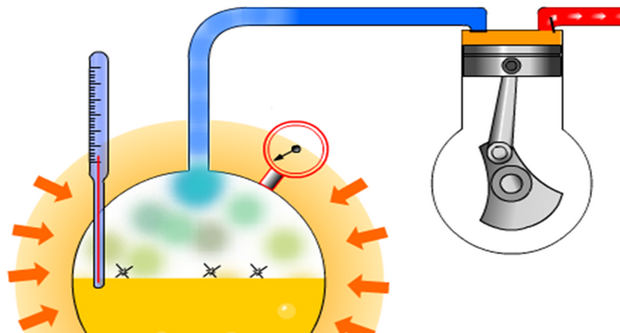Different Effects on Evaporator Temperatur

It is not uncommon, when doing trainings on metering devices in general, but specifically it seems with TXV’s that there is a perception that the TXV is responsible for controlling the temperature in the evaporator. Lets look at a TXV equipped system and how it behaves.
The key here is the word “control” and how it differs from “has an effect on”. Being adjustable, if the TXV controlled evaporator temperature, then you would be able to adjust it (TXV) to control the evaporator temperature to maintain a desired level. From this point of view, you pretty much couldn’t get farther from the truth. In fact the TXV couldn’t give a crap about the evaporator temperature. It will happily regulate refrigerant for evaporator temperatures for freezers right up to wine coolers with no preference for one over the other.
However, it does have an effect on evaporator temperature by regulating the amount of refrigerant that enters the evaporator. It is not trying to change the temperature but rather regulate the amount of refrigerant based on the level of superheat at the evaporator outlet. The corresponding temperature change is a collateral effect so to speak.
What really controls the evaporator temperature is the compressor, or rather the compressors pumping capacity. How much a fixed speed compressor can pump, all else being the same, is determined by the density of the vapor that is entering it. As the density increases, so will the mass flow that the compressor pumps. When a TXV throttles closed due to a drop in load, it injects less refrigerant into the evaporator. Initially, the compressor will pump more refrigerant than what the TXV is injecting so the pressure in the evaporator will drop. However, as the pressure drops, so will the pumping capacity of the compressor. Eventually, the pressure will drop until the pumping capacity of the compressor balances the injection rate of the TXV. At this point, the evaporator is producing exactly the same amount of vapor that the compressor is pulling out of it.
Some other factors that control evaporator temperature with a TXV are:
Evaporator rated capacity: When we size components, we do so that they will all have a similar capacity at the desired operating conditions. If the evaporator is undersized compared to the compressor, then it will operate at a lower temperature than what is desired. Vice versa if it is oversized.
Air flow: If the airflow through the evaporator is reduced for whatever reason, or even if the coil is iced up or dirty, then heat flow will be restricted. The TXV responds by throttling closed. As we saw above, this will result in a reduced evaporator temperature. It will also result in low evaporator superheat. (This is also a critical time that you hope the TXV sensing bulb is securely mounted and insulated!)
Room Thermostat Differential: You may wonder how the room t-stat can have an effect on the evaporator temperature but it does. As the load is reduced in the space, the temperature and humidity in the space is also reduced. Since there must be a differential across the evaporator in order for heat to flow, the evaporator temperature will also drop. If the differential setting on the t-stat is large, expect wide temperature swings for both the space as well as the evaporator between the start and stop of the cycle. Also expect more dehumidification to occur.
Latent load: I have ran into situations where a lack of understanding concerning wet bulb and load led to some unneeded superheat adjustment with predictable results. Residential AC is probably the best example of this around. I find that those who do not understand wet bulb also do not use charging charts either. The reason is obvious. You need to use wet bulb to use a charging chart. Since the dry bulb temperature in AC systems is high compared to refrigeration, it can also hold a lot more moisture. This moisture is latent heat and it is a heat load on the evaporator. If it is high, expect a higher evaporator temperature. If you increase the RH in a room temperature space say 20%, then expect a rise of at least several degrees in the evaporator.
Outdoor ambient: This does not have nearly as much to do with heat load from outside as it does on it’s effect on condensing pressure. When the temperature outside is 75F, your condensing pressure is a lot lower than when it is 95F outside. When the ambient temp is low, the lower pressure differential across the TXV will require it to open more to get the same feed. If the ambient gets too low and you have no way to maintain adequate condenser pressure, then the capacity of the TXV can drop to the point where it behaves like a much lower capacity valve. Expect low evaporator temperatures and high superheat.
Refrigerant charge: Suffice it to say that if you do not have enough refrigerant in the system, expect low evaporator temperatures and high evaporator superheat. In AC, you may see ice at the inlet of the circuits. Also expect your condenser subcooling to be in the toilet and to have flash gas at the TXV inlet. One thing to remember is that a blockage in the liquid line will also give you flash gas and low evaporator temperatures, but the difference will be that the condenser subcooling will not be low as it is when the system is undercharged.
Note: When I refer to evaporator temperature in this article, I am referring to the saturation temperature which is directly linked to pressure. I am not referring to the refrigerant temperature leaving or the average evaporator temperature measured across multiple locations. While these are important, they can differ significantly from the saturation temperature and give false impressions if used instead of saturation temperature. More on this in a future article I promise.
Jamie Kitchen
Training Manager at Danfoss
